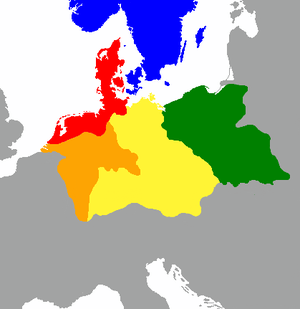Ingvaeonic languages
| Ingvaeonic | |
|---|---|
| Geographic distribution: | Originally the North Sea coast from Friesland to Jutland |
| Linguistic classification: |
|
| Subdivisions: |
|
| Glottolog: | nort3175[1] |
|
The distribution of the primary Germanic dialect groups in Europe in around AD 1:
North Sea Germanic, or Ingvaeonic
Weser-Rhine Germanic, or Istvaeonic
Elbe Germanic, or Irminonic
| |
Ingvaeonic /ˌɪŋviːˈɒnɪk/, also known as North Sea Germanic, is a postulated grouping of the northern West Germanic languages, comprising Old Frisian, Old English[2] and Old Saxon.[3]
Ingvaeonic is named after the Ingaevones, a West Germanic cultural group or proto-tribe along the North Sea coast. It is not thought of as a monolithic proto-language, but rather as a group of closely related dialects that underwent several areal changes in relative unison.[4]
The grouping was first proposed in Nordgermanen und Alemanen (1942) by German linguist and philologist Friedrich Maurer, as an alternative to the strict tree diagrams which had become popular following the work of 19th century linguist August Schleicher and which assumed the existence of a special Anglo-Frisian group.[5] The other groupings are Istvaeonic, from the Istvaeones, including Dutch, Afrikaans, and related languages; and Irminonic, from the Irminones, including the High German languages.
Characteristics
Linguistic evidence for Ingvaeonic are common innovations observed in Old Frisian, Old English and Old Saxon such as the following:
- The so-called Ingvaeonic nasal spirant law, which (e.g.) converted *munþ "mouth" (cf. Old High German mund) into *mūþ (cf. Old English mūþ).
- The loss of the Germanic reflexive pronoun
- The reduction of the three Germanic verbal plural forms into one form ending in -þ
- The development of Class III weak verbs into a relic class consisting of four verbs (*sagjan "to say", *hugjan "to think", *habjan "to have", *libjan "to live")
- The split of the Class II weak verb ending *-ō- into *-ō-/-ōja-
- Development of a plural ending *-ōs in a-stem nouns (note, Gothic also has -ōs, but this is an independent development, caused by terminal devoicing of *-ōz)
- Possibly, the monophthongization of Germanic *ai to ē/ā, and *au to ō/ā (this may represent independent changes in Old Saxon and Anglo-Frisian)
Several, but not all, of these characteristics are also found in Dutch, making it a "transitional" form between Ingvaeonic on one side and Central German on the other. It did not generally undergo the nasal spirant law (except for a few words), it kept the three plural endings distinct, and it did not have the -s plural. But it did undergo near-full monophthongization (some instances of -ei- persisted), it did lose the reflexive pronoun (and later regained it through borrowing), and had the same four relic verbs in weak class 3.
See also
- East Germanic languages
- Irminonic languages
- Istvaeonic languages
- North Germanic languages
- West Germanic languages
References
- ↑ Nordhoff, Sebastian; Hammarström, Harald; Forkel, Robert; Haspelmath, Martin, eds. (2013). "North Sea Germanic". Glottolog. Leipzig: Max Planck Institute for Evolutionary Anthropology.
- ↑ Also known as Anglo-Saxon.
- ↑ Some include West Flemish. Cf. Bremmer (2009:22).
- ↑ For a full discussion of the areal changes involved and their relative chronologies, see Voyles (1992).
- ↑ "Friedrich Maurer (Lehrstuhl für Germanische Philologie - Linguistik)". Germanistik.uni-freiburg.de. Retrieved 2013-12-01.
Further reading
- Bremmer, Rolf H. (2009). An Introduction to Old Frisian. Amsterdam: John Benjamins B.V. ISBN 978-90-272-3255-7.
- Euler, Wolfram (2013). Das Westgermanische - von der Herausbildung im 3. bis zur Aufgliederung im 7. Jahrhundert - Analyse und Rekonstruktion (West Germanic: from its Emergence in the 3rd up until its Dissolution in the 7th Century CE: Analyses and Reconstruction). 244 p., in German with English summary, London/Berlin 2013, ISBN 978-3-9812110-7-8.
- (German) Maurer, Friedrich (1942) Nordgermanen und Alemannen: Studien zur germanischen und frühdeutschen Sprachgeschichte, Stammes- und Volkskunde, Strasbourg: Hüneburg.
- Ringe, Donald R. and Taylor, Ann (2014). The Development of Old English - A Linguistic History of English, vol. II, 632p. ISBN 978-0199207848. Oxford.
- (German) Sonderegger, Stefan (1979). Grundzüge deutscher Sprachgeschichte. Diachronie des Sprachsystems. Band I: Einführung – Genealogie – Konstanten. Berlin/New York: Walter de Gruyter. ISBN 3-11-003570-7.
- Volyes, Joseph B. (1992). Early Germanic Grammar: Pre-, Proto-, and Post-Germanic. San Diego: Academic Press. ISBN 0-12-728270-X.
| ||||||||||||||||||||||||||||||||||||||||
| ||||||||||||||||||||||||||||||||||||||||||
